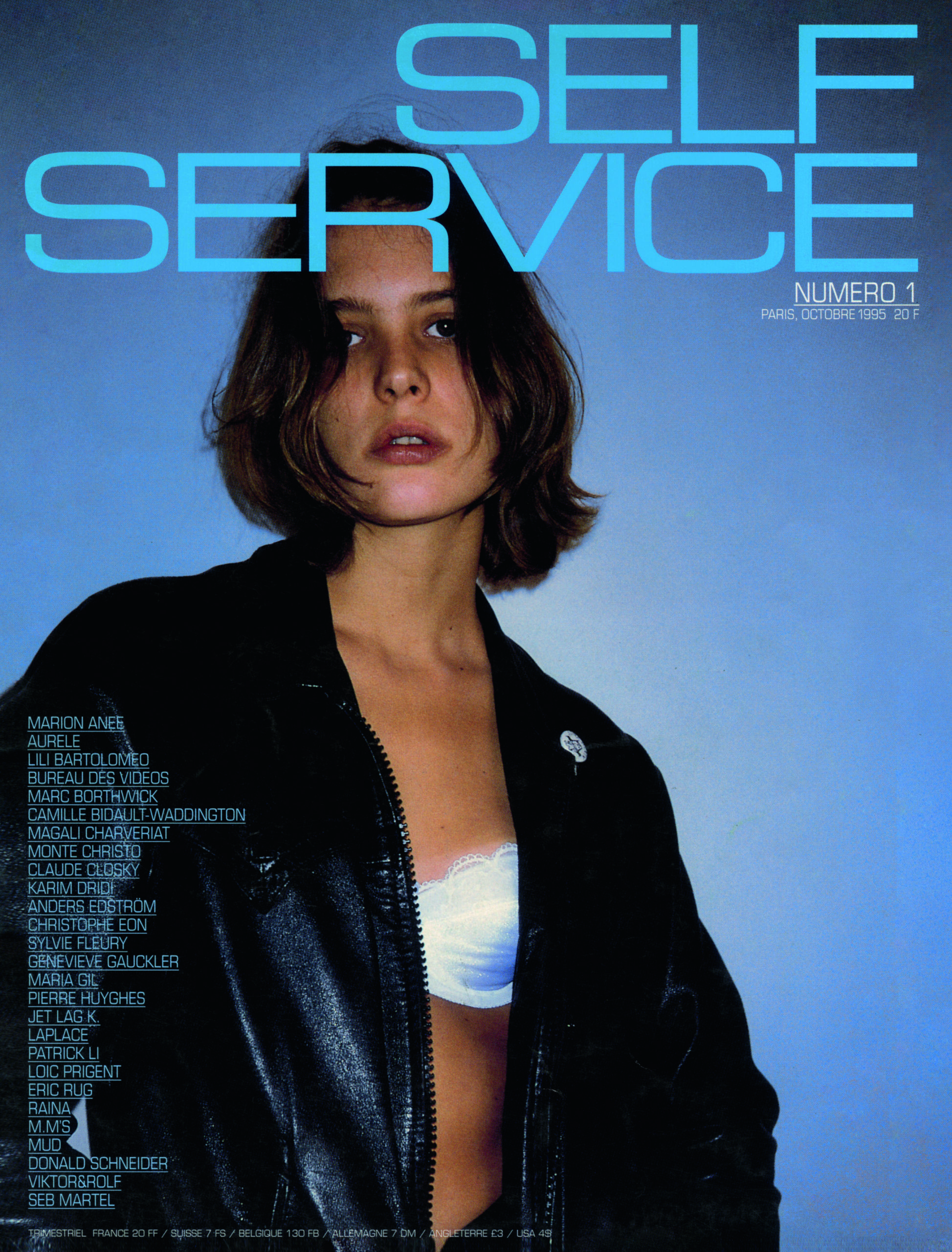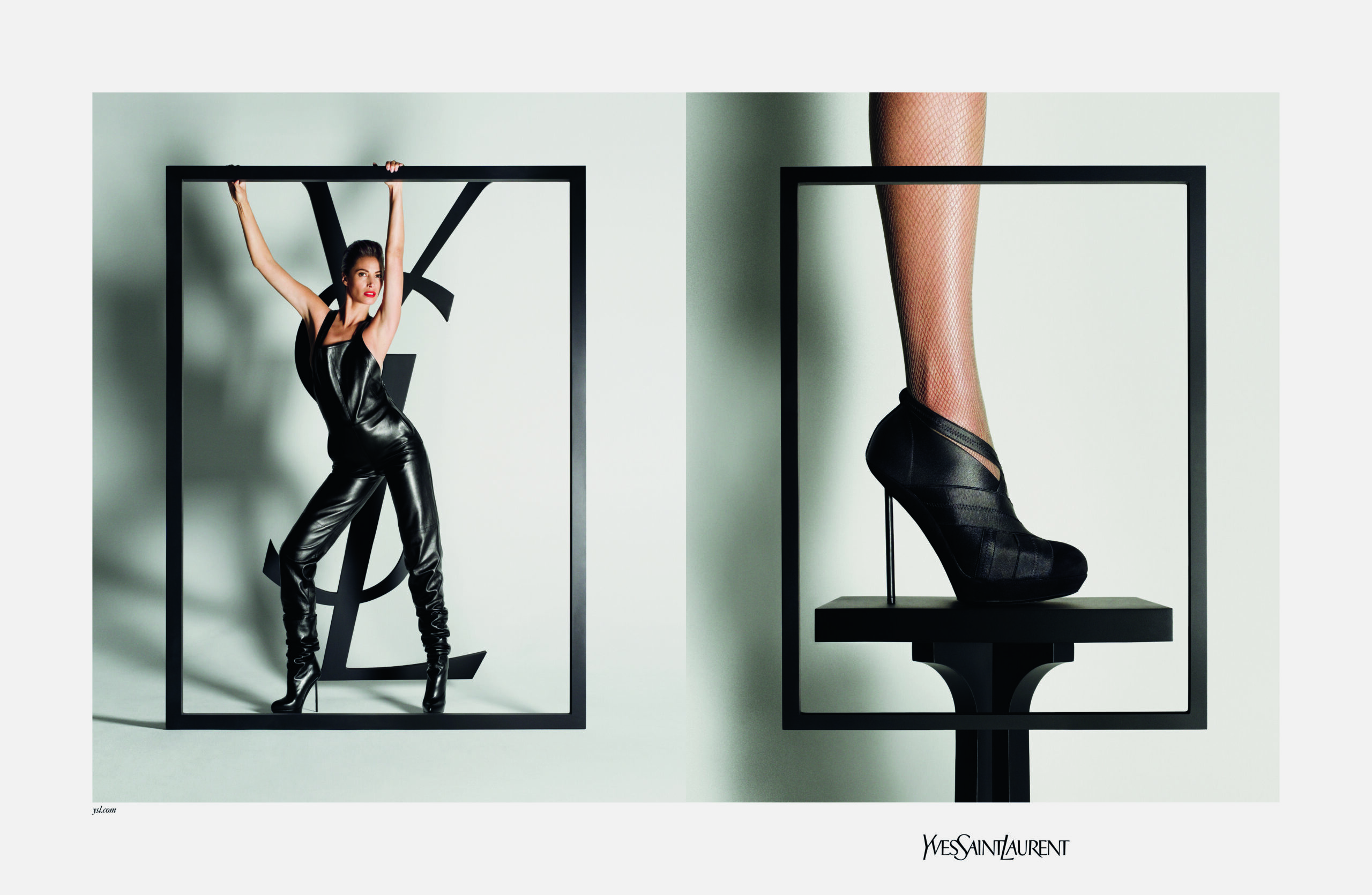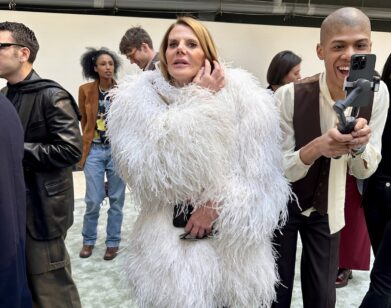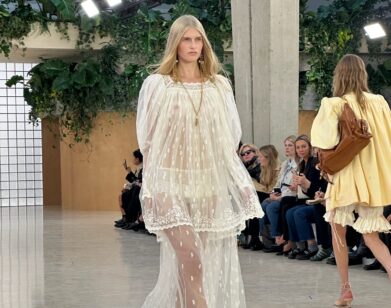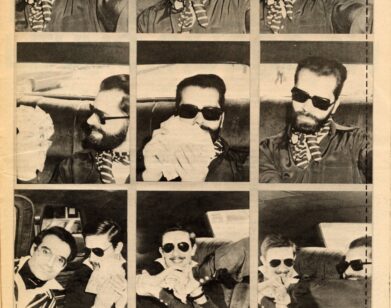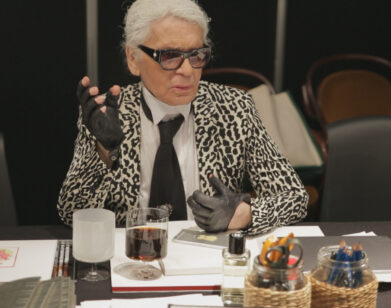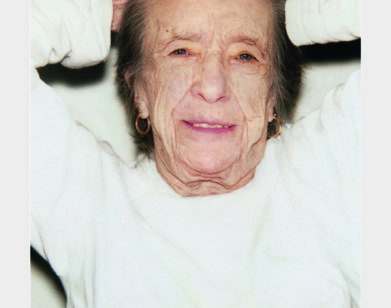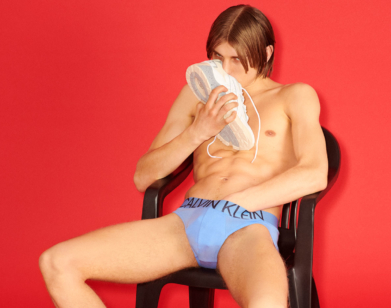nineties
Ezra Petronio and Mel Ottenberg on Self Service, Big Shots, and the Stodgy French
Ezra Petronio co-founded the cult fashion biannual Self Service in a time when the magazine establishment was very conservative, he tells Mel Ottenberg when the two met up in Paris, where the magazine was founded. Pre-internet, play was encouraged, and tight budgets were a thrill. In his new retrospective monograph, Ezra Petronio: Visual Thinking & Image Making, released last month with Phaidon, the celebrated creative looks back on three decades of Self Service, his strategic agency, Petronio Associates, and his Big Shot Polaroid series. Last month, during Paris Fashion Week, he and Mel got together to exchange fond memories of ‘90s Interview, crashing fashion shows, and tales of their hungry youth.
———
MEL OTTENBERG: Remind me for the record what your run-in with Interview was when you were a teenager.
EZRA PETRONIO: My senior year at Parsons in ‘91. I interned there for six months under Tibor Kalman. I was just picking up coffee and going to the Limelight parties. It was really fun.
OTTENBERG: What was Interview like then?
PETRONIO: It was a very different mindset from interns today. I was just happy to be there. Once he came in while doing Colors Magazine and I was called in to the library. I went there super nervous and he did a little scribble. He said, “Try this design for the front of the book.” I took the piece of paper so proudly and did my single-page design.
OTTENBERG: I was an intern at Marc Jacobs and I sometimes think about the weird things I did as an intern.
PETRONIO: I interned at a magazine in Paris called Paris Fashion. My father was an art director. He pushed me since I was a kid to work. But that’s the beauty of that time, we had time to learn and take our time. But what [about you]? I’m just interested.
OTTENBERG: So I’m from Washington DC. I graduated in high school in 1994, which was the height of club kids and Club USA, and I was too much of a druggie teenager to go to Parsons. I’d flunk out in one year, so I went to RISD and I studied fashion design. I moved to New York in 1998 and I got a job as a trim guy at this hot brand. I hated the trim stuff, the buttons and zippers. I was just going out a lot, and I met Alexei Hay and he was like, “We’re going to do Self Service.” Do you remember the Self Service with the girl with all the bug bites that’s in the trees and the Chanel?
PETRONIO: Oh, yeah.
OTTENBERG: He was like, “Get some Chanel suits and then you’ll do a shoot for Self Service.” I’m like, oh my god, this is amazing. On Friday he called me and said, “What’d you get?” And I said, “I don’t know how to call in Chanel suits, but if you lend me your credit card, I’ll buy some at Bergdorf Goodman and then we can return them after the shoot.” And then he hung up on me and I thought I’ll never get another chance to be a stylist.
PETRONIO: [Laughs] That’s so good.
OTTENBERG: He had introduced me to Matthias [Vriens], and I ran into Matthias twice on the street while wearing a cool outfit each time. I had this friend Doug, who’s really great looking. He said, “Why don’t you style Doug the way you dress for The Face?” So I did that. Then I did a shoot for Deliciae Vitae and the editor-in-chief told me, “I think you’ve really got something.” So I thought, okay, I’ll just be a stylist. Of course, it was very hard. I met Steven Klein, who also went to RISD, and he told me to start shooting Vogue and Vogue Italia with him. And then it just started. What’s your story?
PETRONIO: I was immersed really young because my father’s an art director. He was born in New York. I was born in New York, and he moved to Europe when I was a really young kid to open an agency in Paris. My mom was an amazing tap dancer, one of the most iconic dancers, so I really grew in this immersive creative sphere. He would take me on shoots when I was seven years old, and I just observed a lot. I just loved organizing things. I’m really good at putting people together. It’s something I love doing. So when I was in high school in France, I started the high school newspaper. When I went to Parsons, I was the editor of the Parsons newspaper. I was always into graphic design as my skill set. Typography and editorial magazine publishing is something I had in me since the beginning, and the power that we had, the capacity of representing what we believe in. In high school it’s your fellow students, but at Parsons we’re fighting against Jesse Helms, NEA, fighting for gay rights, against the Iraq War, censorship. It was amazing. That’s why I started at Interview and I wanted to do Self Service very early on. So I moved back to Paris and met Suzanne [Koller]. We started the magazine in Paris in ’94, the first issue was out in ’95. And I had my agency on the other side, because that’s what we really do.
OTTENBERG: Which you started in ’92?
PETRONIO: Yes. [We were] doing real art direction and working with some really good clients in the beginning, with Rei Kawakubo and Comme des Garçons. Everything we did, we did with passion. And the magazine had an amazing start. It was a pre-internet, pre-Eurostar, pre-Collette era. We were inspired by some New York and English magazines like The Face, i-D, that generation. Jefferson had just started Dazed. Olivier [Zahm] was doing Purple, so it was an amazing time. It was just us against them.
OTTENBERG: Us against them, as in?
PETRONIO: The establishment. It was very conservative.
OTTENBERG: Right. And French Vogue was really stodgy at that time.
PETRONIO: And France is very different from America and the UK where they tend to champion their creative communities. They’d just make fun of it. But yet, it was a time in Paris with Viktor and Rolf and Nicolas Ghesquière, Hedi [Slimane], Inez and Vinoodh, there were a lot of really nice things. And all the designers of the era, like Helmut and Rei and Yohji, those were our inspirations. There was a real nineties moment that was amazing. I remember we did our fake Margiela letter invitations because we had the first color Xerox in the office. And we’d go and crash shows. There’s no nostalgia looking back, but it’s nice that we were able to grow starting from then. After the agency developed itself, we did a lot of long collaborations with Chloé, with Phoebe [Philo], with Mrs. Prada, developing the branding with all these amazing mentors. At the same time, [we had] the magazine, without the economic pressure, That’s we didn’t need the revenue. That gave us the freedom to be able to defend our initial mission, which is to celebrate and be a kind of postgraduate program for new talent. So that’s what we’ve kept on doing all these years. It’s been a 29 year journey.
OTTENBERG: Was it inexpensive to print a magazine then?
PETRONIO: Listen, you just did what you had to do. I mean, the first issue—
OTTENBERG: What’s the cover? The black leather jacket with the bra?
PETRONIO: Yes, Mark Borthwick. We had nothing. We had one Heineken ad. Agnes B financed 3,000 euros. We didn’t care. It was amazing. It was stapled, it was black and white, 16 color pages. What a fucking thrill. We just stayed faithful and every couple of years, it grew with our generation. All the way up to issue 13, which was I think in ’97, when we put Nicolas Ghesquière and Veronique Branquinho on the cover with these Dutch photographers, Anuschka [Blommers] and Niels [Schumm] and called it “New Establishment” and it was the bomb.
OTTENBERG: Is that the one before the “Class of 1998” issue? That was my favorite. I still have my original copy.
PETRONIO: The Class of ’98. Wow. Those pictures were amazing.
OTTENBERG: They were amazing. What’s fun about looking at the whole book is that it’s made of a bunch of different identities that you’ve really hammered in over 30 years.
PETRONIO: I’m trying not to be too promotional, but it’s a journey to try to keep it as creative as possible. I structured it in two key parts, showing the art direction, then a part that is more focused on Chloé.
OTTENBERG: It’s great though because it reminds you of how powerful print advertising was. And what a moment all those ads were.
PETRONIO: It was another time, but I can’t forget that era of great advertising. Brands had one big investment in the season. Shoot one campaign where all of the brand values and designers’ visions have been encapsulated, and that shoot would come out in print and on billboards and last 4 or 6 months. So you put a lot of energy and effort into those images and they were seen and experienced many times. Today we do a content campaign, it lasts four days on Instagram and it disappears in the void. It’s replaced by another campaign. There are so many assets and you have so much to shoot, so to be able to keep coherence and creativity is more complicated. It’s a shame because some great things that happen today don’t even get the time to exist. But to return to the book, there’s also a part where I focused more on the graphics of Self Service and my Polaroids, which was my other hat.
OTTENBERG: How did you start that?
PETRONIO: It came from appreciation of having a magazine where you have the privilege of meeting different people all the time, and being like, let’s document this. It’s just such a beautiful thing. So I was looking at digital cameras and I asked the photographer to take pictures. He said, “You’ll never find someone so available, just do it yourself.” I studied photography in school, so it’s not my main skillset, but it’s something I know. And I was obsessed with Andy Warhol, so I tried his camera. What was so amazing about the Big Shot, which is the camera Andy used all the time, is that it’s a fixed focal, meaning you can’t go closer or further, it’ll only be in focus at a certain distance. It has this flash cube that gives a beautiful glow and a really sharp shadow.
OTTENBERG: So it’s either a head and shoulder shot or it’s totally out of focus.
PETRONIO: Exactly. So I fell in love with that format. I bought like 50,000 flash cubes, tons of Polaroids, and I just started. I’ve done like 4,000 portraits. We’d do sessions on a whole issue in Paris. I would get Nicolas Ghesquière, shoot his family and friends, do that with Helmut Lang, go to Boombox in London, to Art Basel. I just moved around the world nonstop documenting.
OTTENBERG: How many flashbulbs do you have left?
PETRONIO: I have about 25,000 left.
OTTENBERG: Oh, you’re great.
PETRONIO: Yeah, but there’s no more film anymore so I’ve just created a new cyber camera that uses the Big Shot, but with a digital back, so I can still shoot. It’s both analog and digital.
OTTENBERG: Wow.
PETRONIO: It took me a year to develop that, but now I’ll be able to continue with the same restraints.
OTTENBERG: Fashion in magazines has changed so dramatically and you’ve been doing this a long time. Are you still into the fashion?
PETRONIO: I think it’s very cyclical. The fashion industry today is more about luxury than it is about clothing today. Cathy Horyn said it well. It’s a business. Brands are growing so much and they have to expand. And to increase your reach, you have to associate with the influencers. It’s this economic pattern of always more that tends to dilute everything. And creatives get sucked in right away because people want novelty. My daughter’s 19 years old, she took a couple of beautiful pictures. She’s approached by every brand. It’s ridiculous. For a young creative, don’t go for the fast track. It’s very easy to be flattered and get sucked in and used, but that’s not going to give you longevity. People should go back to taking time to develop their own personal style and have fun. That’s what I would tell the new generation.
OTTENBERG: It’s funny, when I look back at when I first became a stylist, my work was so fun. And then I started thinking I had to get all serious, which was such garbage until I remembered to just have fun like I was in the beginning.
PETRONIO: You’re having fun now.
OTTENBERG: I’m having so much fun.
PETRONIO: It’s a privileged job. That’s why the last issue of Self Service is kind of funny. We played around because I was getting more and more irritated by this social media language that’s used by everyone.
OTTENBERG: I could never do that because it’s basically how I talk anyways. But you remixed it.
PETRONIO: The reason we did that is because if a photographer posts a picture, whether good or bad, everyone’s going to say it’s iconic, it’s legendary, heart, heart. I was watching this interview and one guy said to the other, “Those pictures we did are going down in history.” I’m like, dude, if it’s going down in history, retire. If you place the bar there, how are you going to push yourself? That’s what annoys me.
OTTENBERG: The legendary issue.
PETRONIO: Yeah. That’s why we gave everyone a cover, even though they’re fake covers in the magazine. Everything was iconic. Everything was legendary. We put emojis. I mean, I love that vocabulary. I say that with my friends. We all fool around. But it’s becoming the age of entitlement.
OTTENBERG: Like, thinking you’re really legendary.
PETRONIO: Or thinking everything is due. Because the system supports anything, it gives this sense of importance to a lot of people. Everyone’s just being used at the end of the day. You’ll be front row until they decide you’re not front row. That’s why I say to focus on creativity and the long run.
OTTENBERG: Well, I’ve done things that will definitely go down in history, but you got to hope for more. Old shit gets old. History is history.
PETRONIO: Like the Kim cover.
OTTENBERG: The Kim cover will go down in history. I always think I need to do shit so Rihanna’s not the top thing in my obituary. Do you have favorite covers of Self Service?
PETRONIO: I would say one of the early Mark Borthwicks, like a Chloë [Sevigny]. She’s so symbolic for me because she’s everything we represented.
OTTENBERG: Yes. The one where she’s hanging out with the radiator.
PETRONIO: You have a good memory.
OTTENBERG: Well, I ripped that off. Here, I’ll show you the rip-off. [Shows phone]
PETRONIO: And I would say the Shalom [Harlow] issue with Inez. That whole energy was amazing. And the Joe McKenna curated issue was amazing too.
OTTENBERG: Is there one concept that you think people remember you and Self Service by?
PETRONIO: It’s definitely the Polaroids. I think it’s also the point of view in fashion. There’s always been a strong fashion identity. And the space we give to our teams to really work, whether they’re established or not. Every time I get an issue back, I get goose pimples because every single story is such a collective effort, and people take it with such respect and they invest a lot. That’s what I love. And then we always explored different things like the movie for our film issue, which is really fun. We’ve played with a lot of new technologies. We did iPad issues, we explored augmented reality. So it’s also kind of a creative lab for the agency to play.
OTTENBERG: Right.
PETRONIO: The book is really meant to be a message to ask, what is art direction? True art direction is a collaborative job, so I want to show all the different aspects of it. We always try to lay out the magazine so it has a real flow from start to end. That’s why we have the change of papers, and the play with type.
OTTENBERG: The cool thing about the type is that it really is rooted in the Warholian seventies.
PETRONIO: Yeah. I use very classic fonts that we twist around and disrupt with leading and size and the way you break words, but the basic elements are quite simple.
OTTENBERG: It’s a weird time. Like you said, fashion’s weird right now, but the world’s so fucked up. Who knows what 2024 is going to look like.
PETRONIO: Exactly. I think fashion represents society, in a way. It’s an amazing industry that demands a lot of us, but gives us a lot. It’s also an industry that attracts a lot of attention and everyone wants to be part of it. It’s kind of a circus in that sense. Can I take you for lunch next time? Or dinner?
OTTENBERG: You can take me for lunch, you can take me for dinner. We can do whatever you want.
PETRONIO: Who’s your partner?
OTTENBERG: I’m single.
PETRONIO: A single man.


